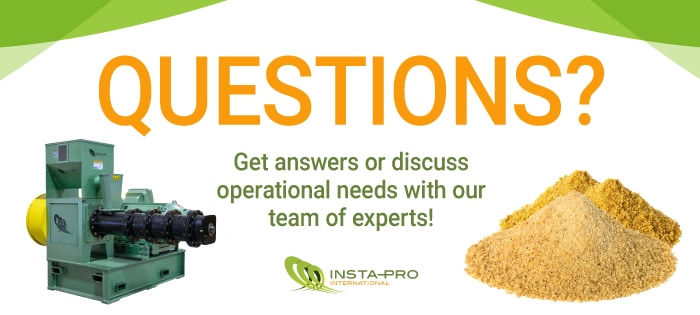Расчет затрат на сушку и нагревание

Инвестиции в завод могут колебаться от начальных инвестиций капитала до текущих затрат. Вот почему наша группа продаж уделяет достаточно времени проведению технико-экономического анализа. После этого мы можем рекомендовать систему, которая позволит вам и вашему бизнесу добиться успеха.
Например, при производстве кормов для рыбы и домашних животных обязательно нужно иметь небольшую сушилка/охладитель. Процентное содержание влаги в продукте, полученном из экструдера, выше стандартного безопасного уровня для хранения, поэтому появляется необходимость в сушильном/охлаждающем оборудовании. Возникает вопрос: «Сколько для этого потребуется энергии?». Приведенная ниже формула поможет предсказать текущие затраты.
Количество исходной воды
Допустим, у нас есть продукт, который на выходе из экструдера со скоростью 1 метрическая тонна в час имеет влажность 20 %. Мы хотим высушить его, чтобы влажность продукта на выходе из сушилки/охладителя составляла 10 % для безопасной упаковки и хранения. Важно отметить, что масса сухого вещества такого продукта, остается постоянной, так мы лишь пытаемся удалить влагу.
Масса сухого вещества следующая:
0,8 × 2200 = 1760 фунтов (сухое вещество)
Это означает, что в продукте 440 фунтов воды (2200 – 1760 или 20 %)
Итоговое количество воды
Чтобы определить потребление энергии при сушке, нам потребуется выяснить, сколько воды при это испарится. Поскольку нам известен вес сухого вещества (1760 фунтов) и окончательное количество влаги (10 %), мы можем рассчитать количество воды, оставшееся в конечном, высушенном продукте.
Мы знаем, что при 10 % влажности 90 % готового продукта составляет сухое вещество. Нужно просто разделить массу сухого вещества на 90 %:
1760 фунтов / 0.9 = 1956 фунта
Это вес готового продукта, который выходит из сушилки при влажности 10 %. Теперь нам известна исходная и итоговая масса продукта, поэтому их разница показывает, сколько воды испарилось во время этого процесса:
2200 – 1956 = 244 фунта (воды/ч удалено)
Примечание: это можно проверить, вычтя это значение из исходной массы воды (440 фунтов) и разделив результат на массу готового продукта (1956 фунтов): (440 – 244) / 1956 = 10 %
БТЕ
Опыт показывает, что для испарения одного фунта воды требуется 1500–1800 БТЕ. Предположим, что требуется 1800 БТЕ. Нам нужно удалять 244 фунта воды в час, поэтому необходимое количество БТЕ:
1800 БТЕ/фунт × 244 фунта/час = 439 200 БТЕ/час
Этот расчет можно использовать при оценке затрат на подбор инженерных сетей и оборудования (сушилок/охладителей, бойлеров и т. д.). Начальные капитальные инвестиции — очень важный фактор, который необходимо учитывать, но текущие затраты, вроде этих, тоже нужно принимать в расчет. Это прекрасная возможность для проведения технико-экономического анализа.


